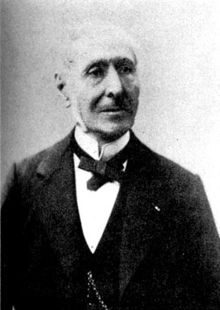Alphonse Pyrame de Candolle
| Alphonse Pyrame de Candolle | |
|---|---|

Alphonse Pyrame de Candolle
|
|
| Born |
28 October 1806 Paris, France |
| Died | 4 April 1893 (aged 86) Geneva, Switzerland |
| Nationality | France Switzerland |
| Fields | botany |
| Institutions | University of Geneva |
| Influences | A. P. de Candolle |
| Influenced | Anne Casimir Pyrame de Candolle, Nikolai Vavilov |
| Notable awards | Linnean Medal (1889) |
| Author abbrev. (botany) | A.DC. |
Alphonse Louis Pierre Pyrame de Candolle (28 October 1806 – 4 April 1893) was a French-Swiss botanist, the son of the Swiss botanist Augustin Pyramus de Candolle.
De Candolle first devoted himself to the study of law, but gradually drifted to botany and finally succeeded to his father's chair at the University of Geneva. He published a number of botanical works, including continuations of the Prodromus in collaboration with his son, Anne Casimir Pyrame de Candolle. Among his other contributions is the formulation, based on his father's work for the Prodromus, of the first Laws of Botanical Nomenclature, which was adopted by the International Botanical Congress in 1867, and was the prototype of the current ICN.
He was elected a foreign member of the Royal Swedish Academy of Sciences in 1859 and was awarded the Linnean Medal of the Linnean Society of London in 1889. He was elected a foreign member of the Royal Netherlands Academy of Arts and Sciences in 1878. He is also known for a study of the religious affiliations of foreign members of the French and British Academies of Science during the Scientific Revolution that demonstrated that in both academies Protestants were more heavily represented than Catholics by comparison with catchment populations. This observation continues to be used (for example in David Landes' 1999 _Wealth and Poverty of Nations, cf. revised paperback edition, 177) as a demonstration that Protestants were more inclined to be scientifically active during the Scientific Revolution than Roman Catholics.
In 1855 de Candolle published Géographie botanique raisonnée This was a ground-breaking book that for the first time brought together the large mass of data being collected by the expeditions of the time. The natural sciences had become highly specialized yet this book synthesized them to explain living organisms within their environment and why plants were distributed the way they were, all upon a geologic scale. This book had a significant impact upon Harvard botanist Asa Gray.
...
Wikipedia
